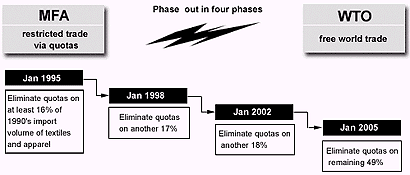|
Exports of textiles and clothing from developing countries have long faced restrictive blocks to their exports called quotas. Brought in force as a temporary relief measure in favour of the domestic textile manufacturers in the developed countries, it has been in force for 40 years now. In 1962, a Long Term Agreement (LTA) regarding international trade in cotton textiles was signed. It replaced the one-year Short Term Agreement that existed at the time. LTA underwent several renewals and was subsequently replaced by the Multi Fibre Agreement (MFA) in 1974, which was expanded to cover exports of synthetic fibres and woolen products, besides cotton. MFA came into force to allocate export quotas to the low cost developing countries, limiting the amount of imports to countries whose domestic industries were facing serious challenge from rapidly increasing imports. It sought to expand trade, reduce barriers to trade and progressively liberalise world trade. The MFA regime existed for 25 years, until 1994 when the Uruguay Round of Multilateral Trade Negotiations resulted in the Agreement on Textiles and Clothing (ATC). The ATC sought to phase out all quota restrictions in four phases spread over a period of 10 years. The first three partial phase-outs were in January 1995, January 1998 and January 2002. The final one is due on January 01, 2005. 
Source: WTO
Technically, until now, 51 per cent of the quotas should have been removed but in reality, only 16 per cent have been actually removed. Even these 16 per cent constitute categories, which were not sensitive for imports into the US and the EU. The commercial significance to the developing countries therefore has been very limited. 1 January 2005 will see the remaining 84 per cent quota restrictions being abolished for all countries barring China, which is expected to continue facing quota restrictions for another three years, with a possible extension till the end of 2011. Though the ATC provided a 10-year phase-out period for quota elimination, the transition period was not well utilised by the exporting countries to gear up for the post ATC regime. With the quota restrictions disappearing from 1 January 2005, competition will intensify. It will enable some developing countries to increase their exports at the cost of smaller countries that enjoyed quota protection and duty free treatment. | The History of International Trade in Textiles and Clothing | | Date Action take | | 1957: January | Five-year agreement reached with Japan on limiting overall textile exports to United States. | | 1958: November | United Kingdom signs "voluntary" limitation on cotton T&C products with Hong Kong after threatening imposition at lower than prevailing volume levels. | | 1959: September | United Kingdom signs similar restraint agreements with India and Pakistan. | | 1960: November | GATT Contracting Parties recognise the problem of "market disruption", even if it is just threatened; serves as "excuse" for establishing future NTBs. | | 1961: July | The Short Term Arrangement (STA) is agreed upon. | | 1962: February | The Long Term Arrangement (LTA) is agreed upon to commence on October 1, 1962, and last for five years. | | 1966: June | The United Kingdom implements a global quota scheme in violation of the LTA. (The LTA provides only for product-specific restraints.) | | 1967: April | Agreement is reached to extend the LTA for three years. | | 196971 | The United States negotiates VERs with Asian suppliers on wool and man-made fibres. | | 1970: October | Agreement is reached to extend the LTA for three years. (It was later extended an additional three months to fill the gap until the MFA came into effect.) | | 1973: December | It is agreed that the MFA will begin on January 1, 1974, and last for four years. | | 1977: JulyDecember | The European Economic Community and the United States negotiate bilateral agreements with developing countries prior to agreeing to extension of the MFA. | | 1977: December | The MFA is extended for four years. | | 1981: December | The MFA is renewed for five years. The United States, under pressure from increased imports resulting from dollar appreciation, negotiates tough quotas. | | 1986: July | The MFA is extended for five years, to conclude with Uruguay Round. | | 1991: July | The MFA is extended pending the outcome of the Uruguay Round negotiations. | | 1993: December | The Uruguay Round (UR) draft final act provides for a 10-year phase-out of all MFA and other quotas on textiles in ATC. MFA extended until UR comes into force. | | 1995: January | 1 1st ATC tranche liberalised by importing countries 16% of 1990 import volume. | | 1998: January | 1 2nd ATC tranche liberalised by importing countries 17% of 1990 import volume. | | 2002: January | 1 3rd ATC tranche liberalised by importing countries 18% of 1990 import volume. | | 2005: January | 1 4th ATC tranche liberalised by importing countries 49% of 1990 import volume. | Source: Based on D. Spinanger, "Faking Liberalization and Finagling Protectionism: The ATC at Its Best", Background Paper for the WTO 2000 Negotiations: Mediterranean Interests and Perspectives, Cairo.
also see : Indian
garments in a brave new world
The
labour conundrum
Sorry
infrastructure
The
need for labour reforms
The
China syndrome
|